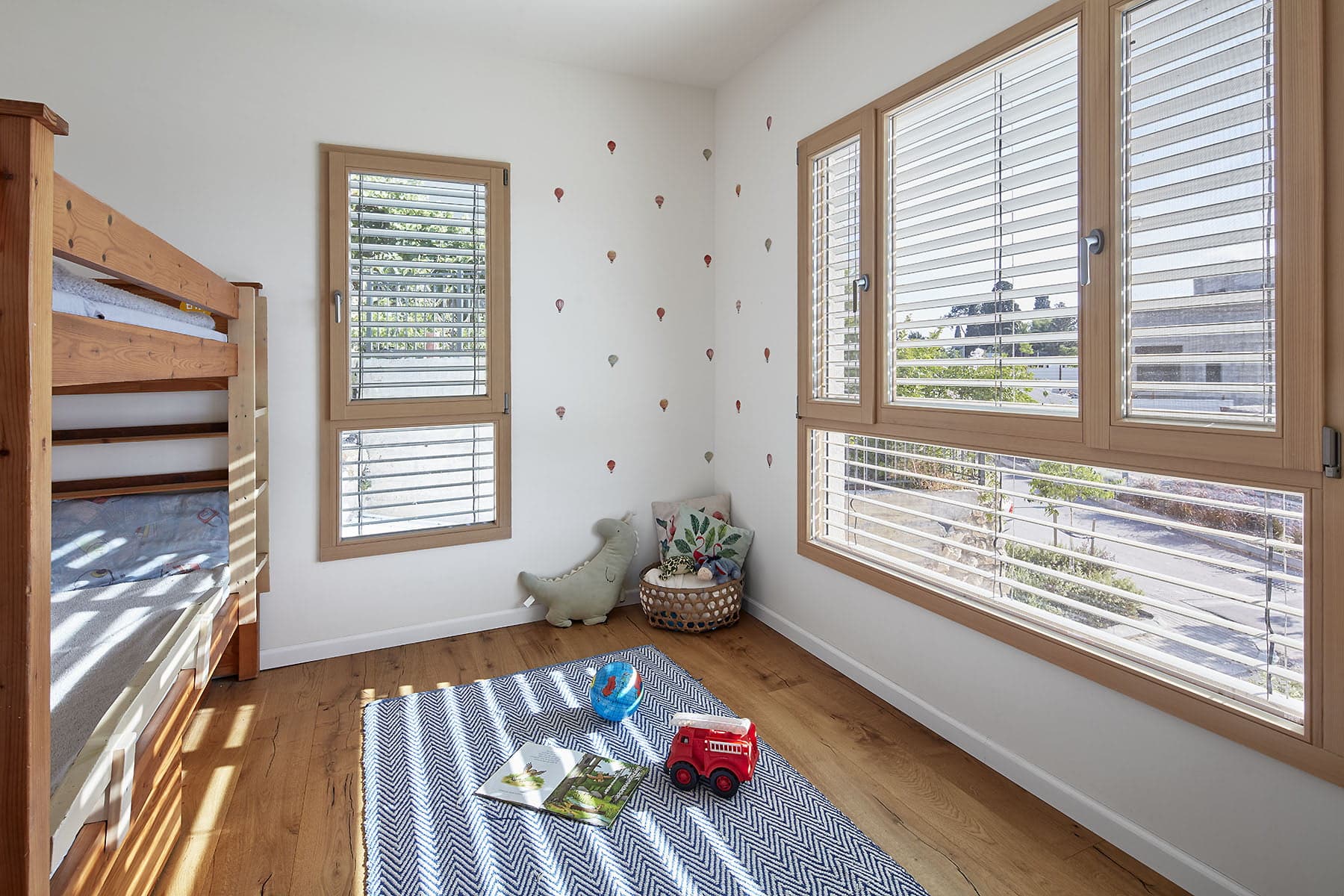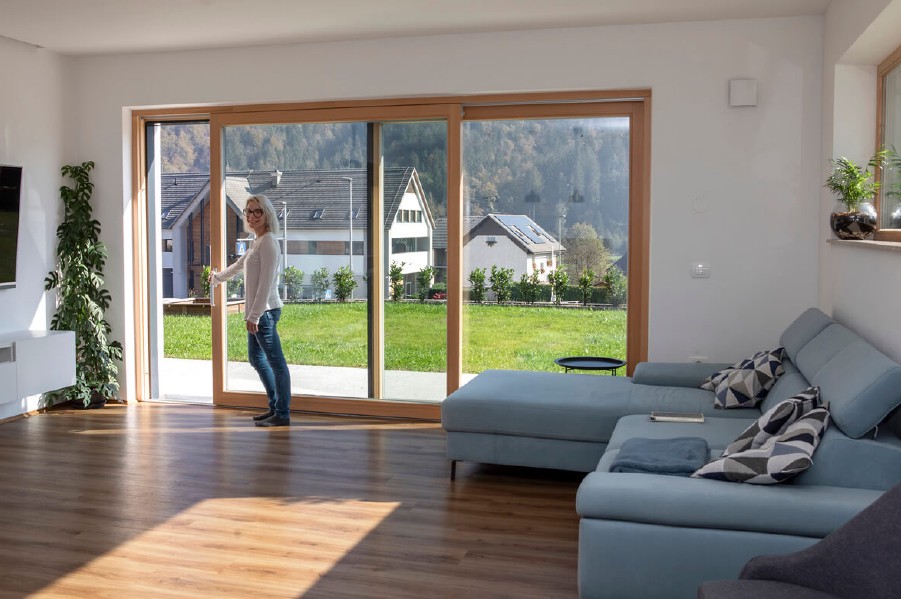Wooden window maintenance

The 101 of maintaining wooden windows
Wood is a natural material that varies in structure, texture, colour tone and performance. All these characteristics give it unique aesthetic and functional properties, posing a significant advantage over synthetic materials. Wood is not everlasting, but it can be highly durable when given proper care.
How much maintenance wooden joinery needs largely depends on the exposure to environmental influences, the cardinal direction they face, the size of the eaves, air pollution as well as the impact of mountain and coastal climates.
You can greatly extend the lifespan of your wooden windows simply by handling them correctly from the moment they are installed.
Immediately after installation
Inspect and test all windows. If any damage occurred during installation, make sure it is repaired as soon as possible. Regularly ventilate the rooms.
1–2 weeks after installation
Clean the glass of the window. Avoid using a coarse cloth or aggressive cleaning agents not to damage the silicone sealant.
6–8 weeks after installation
If necessary, clean the wooden surfaces with a mild cleaning agent, followed by the application of a care product.
For the long-lasting durability of our products, we recommend repeating the cleaning process and application of the care product once or twice annually.
After one year
and then once a year
Thoroughly inspect the windows, including the seals and hardware, to ensure a timely detection of any damage and wear. If necessary, repair the damage, lubricate and adjust the hardware and take care of the aluminium surfaces.
Open the windows wide!
In the morning, ventilate by fully opening your windows and doors for 1–5 minutes. During the day, ventilate as needed by fully opening the windows for 5–10 minutes.
To avoid energy losses, turn off the heating during ventilation. During winter, do not keep the windows open in a tilted position for too long as cooling can cause condensation – condensed moisture can cause long-term damage to the window.

Regular maintenance
Cleaning wooden surfaces exposed to external influences is important to ensure the durability of your windows. This is because as dust, soot and greasy stains often accumulate on external surfaces, causing long-term damage to the wood. Clean the surfaces with lukewarm water, a strongly diluted neutral detergent or soapy water. These agents clean the surface well without causing any damage. Do not use acids, thinners, alcohol or detergents with ammonia as cleaning agents as these substances degrade the coating.
For cleaning glass, we recommend using dedicated glass cleaners. Use a soft cloth to avoid scratching the surface of the glass. Make sure that aggressive cleaners do not come into contact with lacquered surfaces as they can damage the coating, especially if you use alcohol or benzene to remove stubborn stains on glass.
Further care is always performed after cleaning. Touch up the wooden part of the window with one application of a protective water solution containing balm or conditioner, applied either by means of a cloth or sponge. Applying a coating film with a conditioner seals any micro-cracks and creates a new protective layer that shields the wood against external influences. The simple process of touching up the surface greatly increases the life span of the coating.
Handles, hooks and other visible hardware also need cleaning. When performing the cleaning, use designated cleaners and a soft cloth or follow the manufacturer’s instructions.
For cleaning rubber seals, use mild cleaning agents or a special seal cleaner that contains grease and maintains the flexibility of the seal while preventing premature brittleness and thus poor sealing. When cleaning, also check for any damage on the seal. When reapplying coatings on other surfaces, avoid applying the coating to the seal.
After construction and painting are completed, clean the window and front door hardware and lubricate all moving and locking parts with grease or oil spray. Only mild pH-neutral cleaners can be used for cleaning – never use acids, aldehydes, phenol, ammonia, ammonium compounds, amino compounds or polishing agents that contain the aforementioned substances.
Window hardware must not be soiled with mortar or other construction materials or with agents used for restoring the wooden part of the window.
For flawless function, we recommend regular hardware lubrication with acid-free and non-resinous greases once a year .
Anodized surfaces
It is recommended to use only pH-neutral cleaning agents that do not contain abrasive particles. Clean heavily soiled surfaces with specialized cleaning pastes. You can also use diluents, such as benzene, but be sure to follow the usage instructions and safety information for each cleaning agent to avoid damage to seals and painted surfaces or use that is harmful to health.
Powder-coated surfaces (RAL)
Clean the surfaces with mild liquid soap and a soft cloth as needed or at least once a year. The surface should not be directly exposed to the sun during cleaning. For very dirty surfaces, you can use benzene and rinse the surface with clean water afterwards. Household cleaners that contain aggressive substances, such as alcohol or ammonia, are not suitable for cleaning powder-coated surfaces. Minor scratches can be covered with car polishing products of the appropriate color. Follow the usage instructions and safety information for each cleaning agent to avoid damage to seals and painted surfaces or use that is harmful to health.
Occasionally, open the windows and clean the grooves on the sash and frame. If windows are left closed for a long time, impurities and insects can get into them, which can start causing damage.
Service and maintenance
